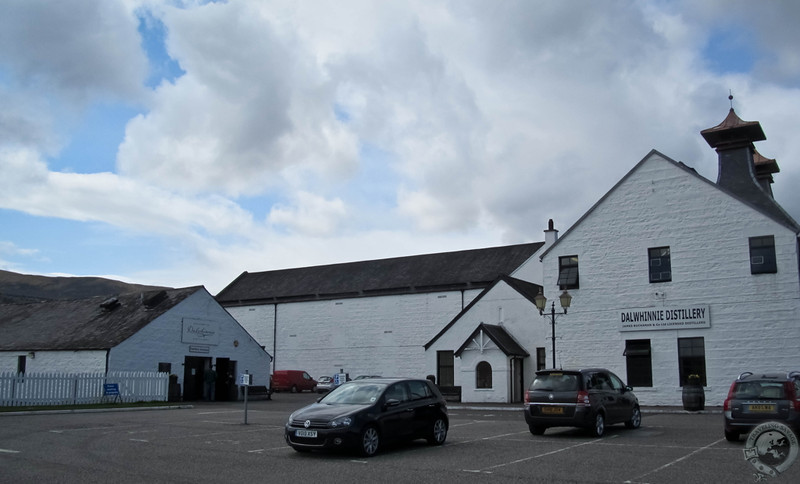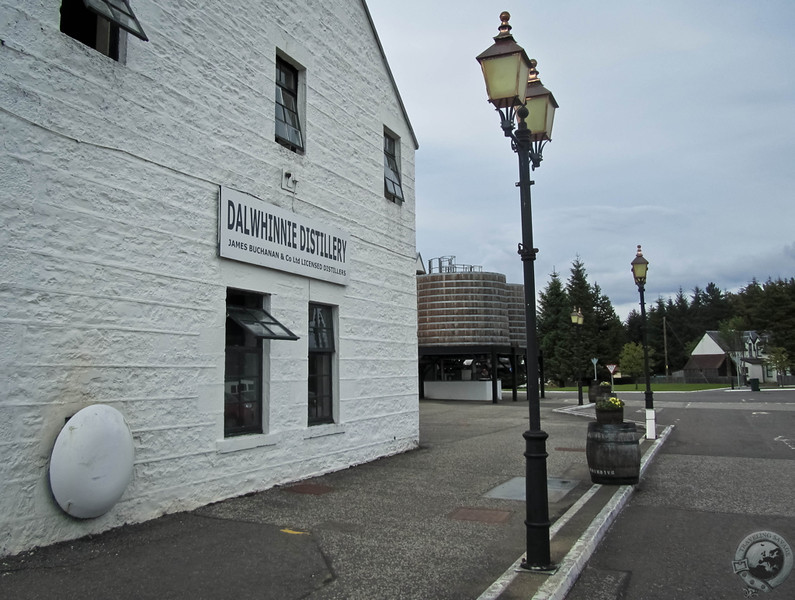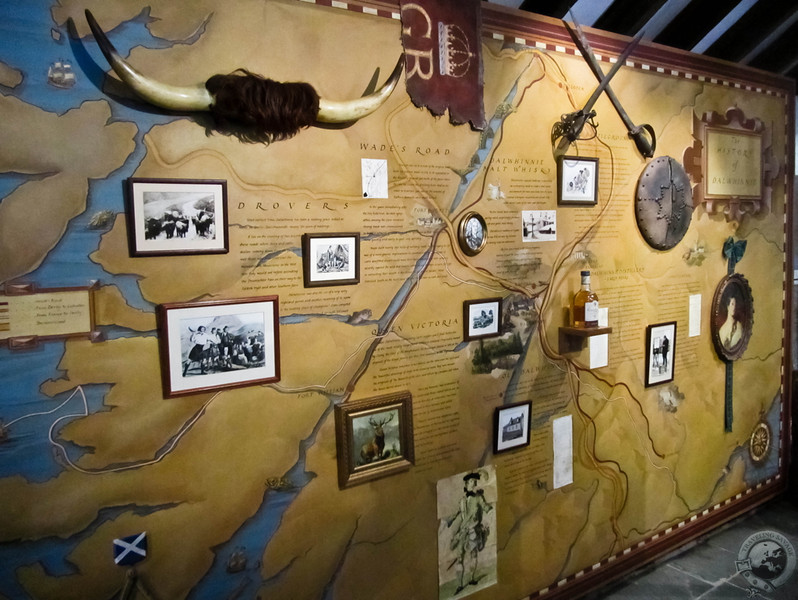It’s good to be back from vacation. Honestly, that’s not a sentence I could have ever anticipated writing, but I won’t miss the constant bombardment of screaming children, endless games of bumper cars with strollers and motorized rascals, and throngs of chanting tour groups. On the other hand, it was a hugely rejuvenating week, and the Wizarding World of Harry Potter at Universal Studios was incredible. Spending so much time with Sarah wasn’t bad either. 😉
What better way to dive back in to Scotland than to serve up a distillery post? And this one’s dear to my heart: Dalwhinnie. To think I didn’t even have a visit planned during my trip last May seems appalling now. In the midst of my best holiday in the world, I scrambled to schedule something – anything – with the fine folks of Scotland’s highest distillery. Little did I know the trip would follow a very long night of drinking with the Technomadics duo at our self-catering house in Nethy Bridge. Thankfully, I lived.
Sarah owes her enjoyment of single malt Scotch whisky to Dalwhinnie. So my does my sister, Stephanie, and so do a lot of other women, I imagine. Perhaps that’s how Dalwhinnie earned the nickname “the lady’s dram.” Guys, don’t be put off. There’s nothing particularly “lady-like” about Dalwhinnie other than, perhaps, the script font on the bottle. We should all be so lucky to have women in our lives who appreciate fine malt whisky. It makes explaining those impulse buys easier. Sadly, you’ll have to share, though.
Dalwhinnie distillery hides in the mountainous pass north of Perthshire and south of Inverness. Frosty peaks loom to either side of the A9, and snow and cold temperatures are common at this altitude. This climate contributes to the character of Dalwhinnie, says Ewan MacKintosh, Dalwhinnie’s brand home manager with whom we met during our short visit. As is common with Diageo employees, Ewan’s rotated through some of their other distilleries, places like Oban and Lagavulin, before settling into the Dalwhinnie family. Family is the operative word: Many of the folks at Dalwhinnie come from families that have worked at the distillery for generations. Most distilleries grow out of family businesses, but Dalwhinnie maintains some of the strongest family ties of any distillery I’ve visited.

John Grant, George Sellar, and Alexander MacKenzie founded the Strathspey distillery in 1898, and AP Blyth renamed it Dalwhinnie later that year when he bought it following the founders’ bankruptcy. Dalwhinnie changed ownership several more times in its youth, but the folks actually making the whisky remained a hallmark constant through the 20th-century and beyond. The distillery burned down in 1934 – alcohol vapors are dangerous – and didn’t reopen until 1938. Other than shutting down during WWII, Dalwhinnie has been going strong ever since.
Dropping in, as I was, Ewan kindly agreed to take us on a quick tour of the distillery after some tea and a brief chat. For the large size of mindshare that Dalwhinnie has with me, the operation itself is smaller than I expected. Two large stills rumble away in the stillhouse while the sound of gushing wort filling one of their six washbacks nearly drowns out my recording of our chat. They schedule a long fermentation in the washbacks – the length of fermentation yields different flavors in the wash. Dalwhinnie is a lightly-peated whisky with about two tons in every nine being peated malt. In total, Dalwhinnie produces about two million liters of spirit each year, which makes it a mid-range producer in terms of volume.
Ewan pointed out they aim for a heavier spirit during production, so newmake experiences a smaller period of copper contact in the stills and condenser. In fact, like Edradour and Lochnagar, Dalwhinnie uses worm tubs to condense the alcohol vapor back into liquid. A worm tub is like a giant barrel filled with water in which a large coil of copper pipe sits. The alcohol vapor from the still travels down this coil, cools, and condenses. It’s an old style of condenser, and Dalwhinnie fills their tub with ice-cold water from the mountains to ensure the vapor condenses quickly. Since the newmake spends little time as a vapor in contact with the copper piping, many chemical “impurities” like sulphur remain that give it a heavier character.
The warehouse is filled with refill Bourbon barrels working hard to create Dalwhinnie’s final product. Amongst the hogsheads hides the infrequent Sherry butt, which is used in Dalwhinnie’s Distiller’s Edition. Ewan produces a long, metal valinch and hands it to Sarah, and then moves over to a barrel and removes the bung. He shows her how to siphon whisky out of the barrel and gives her a glass in which he instructs her to add a dram.
Sarah fills up the entire glass (that’s my girl). Thirsty, are ya? Ewan says. He pours some back into the barrel and leaves us with a healthy triple dram of cask-strength single-cask Dalwhinnie that we bring with us as we move on to the visitor’s center. The whisky is rich and explosive with sweet cakey and vanilla flavors and a lighter, citrusy note in the background. The mouthfeel is creamy and wonderful.
Dalwhinnie’s standard bottle is a 15-year old expression, which is significantly older than the 10- or 12-year bottles you find as entry-level whiskies from other distilleries. Here’s the secret: the character of the newmake spirit determines the length of time that the spirit needs to spend in the barrel. Whisky gets the majority of its flavor from the wood of the barrel, but this wood also filters out unwanted flavors from the newmake. In Dalwhinnie’s case, it takes a good 15 years of maturation to remove the unwanted sulphury notes. The result is a full-bodied whisky with prominent honey, sweet malty, fruity, vanilla, and fireworks (yes, fireworks!) notes.
Dalwhinnie’s whisky has historically been an important element of Buchanan’s blends (such as Black & White), but most know the distillery today for its 15-year old single malt that you can find in most good liquor stores here in the States. It’s a perfect dram before dinner, and an excellent bottle to have around the house. Just don’t be surprised, guys, if your girlfriend/wife/sister/mom grows a fondness for it.
Many thanks to Diageo and Ewan MacKintosh for hosting my visit. As always, all opinions expressed here are my own.



I’m with you on Dalwhinnie being a great dram. Ladies may appreciate it but it’s a dram everyone can enjoy.
Agreed, it’s a classic.